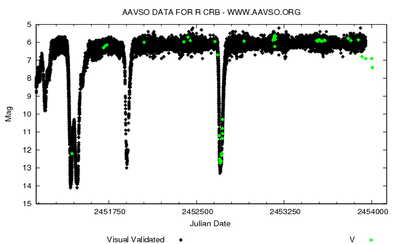R Coronae Borealis
R Coronae Borealis | |
| Observation data Epoch J2000.0 Equinox J2000.0 | |
|---|---|
| Constellation | Corona Borealis |
| Right ascension | 15h 48m 34.4149s |
| Declination | +28° 09′ 24.296″ |
| Apparent magnitude (V) | 5.9m |
| Characteristics | |
| Spectral type | G0Iab:pe |
| B−V color index | 0.56 |
| V−R color index | 0.0 |
| J−H color index | 0.275 |
| J−K color index | 0.8 |
| Variable type | R CrB |
| Astrometry | |
| Radial velocity (Rv) | 24.8 km/s |
| Proper motion (μ) | RA: -2.10 mas/yr Dec.: -11.52 mas/yr |
| Parallax (π) | 0.54 ± 0.72 mas |
| Distance | 6,200[1] ly (1,900[1] pc) |
| Absolute magnitude (MV) | −5.85[1] |
| Details | |
| Mass | ~0.8 M☉ |
| Luminosity | ~19,000[1] L☉ |
| Surface gravity (log g) | 0.15[1] cgs |
| Temperature | 6,900[1] K |
| Other designations | |
R Coronae Borealis, R CrB, V* R CrB, GSC2 N1330022410, 2MASS J15483440+2809242, AG+28° 1513, GSC 02039-01605, N30 3552, TD1 18592, BD+28° 2477, HD 141527, PLX 3581, TYC 2039-1605-1, EM* CDS 886, PPM 104338, GC 21257, HIP 77442, RAFGL 4219, YZ 28 7350, GCRV 9116, HR 5880, ROT 2225, AAVSO 1544+28A, IRAS 15465+2818, SAO 84015. | |
| Database references | |
| SIMBAD | data |
R Coronae Borealis is a yellow supergiant star, and is the prototype of the RCB class of variable stars, which fade by several magnitudes at irregular intervals. R Coronae Borealis itself normally shines at approximately magnitude 6, just about visible to the naked eye, in the constellation of Corona Borealis, but at intervals of several months to many years fades to as faint as magnitude 14. Over successive months it gradually returns to its normal brightness, giving it the nickname "Fade-Out star," or "Reverse Nova".
Properties

The cause of this behaviour is believed to be a regular build-up of carbon dust in the star's atmosphere. The sudden drop in brightness may be caused by a rapid condensation of dust, resulting in much of the star's light being blocked. The gradual restoration to normal brightness results from the dust being dispersed by radiation pressure.
Even basic data for this star is not known with any accuracy. It is too distant for accurate direct measurement and models of the class are poorly defined.
These declines in magnitude come about as dust that has been ejected from the star obscures it. Direct imaging with the Hubble Space Telescope shows extensive dust clouds out to a radius of around 2000 astronomical units from the star, corresponding with a stream of fine dust (composed of grains 5nm in diameter) associated with the star's stellar wind and coarser dust (composed of grains with a diameter of around 0.14µm) ejected periodically.[2]
History
Variability of R CrB has been discovered by the English astronomer, Edward Pigott in 1795.[3][4] It was known as Variabilis Coronae,[5] "Variable of Corona". In 1935 it was the first star shown to have a different chemical composition than the sun via spectral analysis.[6][7]
It is one of the three brightest R Coronae Borealis stars visible to Earth observers, along with RY Sagittarii and V854 Centauri.[8]
References
- ↑ 1.0 1.1 1.2 1.3 1.4 1.5 Bibcode: 1975A&A....44..383S
- ↑ Jeffers, S. V.; Min, M.; Waters, L. B. F. M.; Canovas, H.; Rodenhuis, M.; de Juan Ovelar, M.; Chies-Santos, A. L.; Keller, C. U. (2012). "Direct imaging of a massive dust cloud around R Coronae Borealis". Astronomy & Astrophysics 539 (A56): 1–8. Bibcode:2012A&A...539A..56J. doi:10.1051/0004-6361/201117138.
- ↑ Frommert, H., Kronberg, Ch., R Coronae Borealis: SEDS
- ↑ Davis, Kate (January 2000). ["R Coronae Borealis". Variable star of the season. AAVSO. Retrieved 14 March 2015.
- ↑ Allen, R. H., (1963) Star Names: Their Lore and Meaning, (rep.) Dover Publications, Inc., p. 178.
- ↑ Hockey, Thomas (2009). The Biographical Encyclopedia of Astronomers. Springer Publishing. ISBN 978-0-387-31022-0. Retrieved August 22, 2012.
- ↑ Berman, Louis (1935). "The Spectrum Analysis of the Hot Carbon Star, R Coronae Boreali". The Astrophysical Journal 81: 369. Bibcode:1935ApJ....81..369B. doi:10.1086/143644. Retrieved August 22, 2012.
- ↑ Skuljan, L.; Cottrell, P. L. (2002). "Recent declines of RS Telescopii, UW Centauri, and V Coronae Australis". The Observatory 122: 322–29. Bibcode:2002Obs...122..322S.
R Coronae Borealis was featured in a science fiction short story, "Cold Front" by author Hal Clement published in 1946 in the magazine Astounding Science Fiction.
| ||||||||||||||||||||||||||||||||||||||||||||||